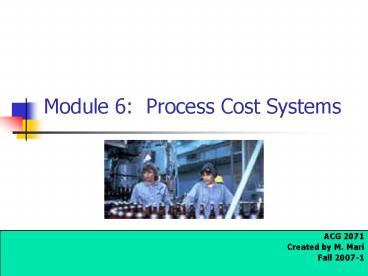Module 6: Process Cost Systems - PowerPoint PPT Presentation
1 / 22
Title:
Module 6: Process Cost Systems
Description:
Process Cost Is the mass production of products in a continuous flow of steps Products ... Each process is identified a separate production, department, ... – PowerPoint PPT presentation
Number of Views:108
Avg rating:3.0/5.0
Title: Module 6: Process Cost Systems
1
Module 6 Process Cost Systems
- ACG 2071
- Created by M. Mari
- Fall 2007-1
2
Process Cost
- Is the mass production of products in a
continuous flow of steps - Products pass through a series of sequential
processes - Each process is identified a separate production,
department, workstation, or work center. - With the exception of the first process or
department, each receives the output from the
prior department as a partially processed
product. - Depending on the nature of the process, a company
applies direct labor, overhead, and additional
direct materials to move the product toward
completion
3
Process Cost Accounting
- Assigns direct materials, direct labor, and
overhead to specific processes. - Costs are allocated by department rather than
jobs - Manufacturing costs are allocated to products
based on units of production - Manufacturing costs are accumulated and
transferred by department - The total costs associated with each process are
then divided by the number of units passing
through that process to determine the cost per
equivalent units for that process
4
Cost Flows
Mixing
Materials Raw
Bottling
Packing
5
First In, First Out Method
- Assume that the product moves in order throughout
the production process - Determine units to be assigned costs
- Units in beginning work in process
- Units started and completed during period
- Units in ending work in process
6
FIFO Method
- Calculate Equivalent Units of Production
- Process manufacturers often have some partially
processed materials remaining at the end of the
period - EUP
- Number of units that could have been completed
within a given accounting period
7
Example 1
- A company processes their production in two
departments. Beginning inventory was 500 units
that were 70 completed, 1,100 units transferred
out to the next department and ending inventory
consisted of 400 units 25 completed.
8
Example 1
Actual Units EUP
Beg. Inv. 500 30 150
Started Completed Transferred in 1,100 Units in Beg. Inv - 500 600 100 600
Ending Inv. 400 25 100
Total 850
9
Example 3
- A company process their production in two
departments. The beginning inventory was 4,000
units 50 completed, transferred into the
department 5,000 units and an ending inventory of
2,000 units 40 completed.
10
Example 3
Actual Units EUP
Beg. Inventory 4,000 50 2,000
Started Completed Transferred in 5,000 Ending inventory 2,000 3,000 100 3,000
Ending Inventory 2,000 40 800
Total 5,800
11
Determine cost per equivalent unit
- Material cost based on actual units transferred
into the department - Assume at beginning of the period
- Conversion costs
- Direct labor Factory overhead
- Based on EUP
12
Example 4
- Using the production units given in Example 1,
assume that direct material costs are 50,000.
Factory overhead is 3,000 and direct labor is
6,690. Work in process account has a balance of
28,150 at the beginning of the month which is
from this months beginning inventory. Complete
the chart
13
Example 1
Actual Units EUP
Beg. Inv. 500 30 150
Started Completed Transferred in 1,100 Units in Beg. Inv - 500 600 100 600
Ending Inv. 400 25 100
Total 850
14
Example 4
- Direct materials per actual unit
- Actual units are the units that are added this
period. - They are the units started and completed and the
units in ending inventory. - Ending inventory
400 units - Started and Completed
600 - Total actual units
1,000 - Direct materials per actual units Direct
material costs -
Actual units - 50,000
- 1,000 units
- 50 per actual unit
placed into production this period. - Started and completed units 600 X 50 30,000
- Ending inventory units 400 X 50 20,000
15
Example 4
Actual Units EUP Material Conversion Costs Total
Beg. Inv. 500 30 150
Started Completed 600 100 600 600X 50 30,000
End. Inv. 400 25 100 400 x 50 20,000
850
16
Example contd
- Conversion costs
- Direct labor Factory overhead
- 6,690 3,000
- 9,690
- Are divided by Total EUP
- Conversion costs per EUP
- Total conversion costs
- Total EUP
- 6,690
- 850
- 11.40 per EUP
17
Example 4
Actual EUP Mtrl Conversion Costs Total
Beg. Inv. 500 30 150 11.40 X 150 1,710
Started Completed 600 100 600 30,000 11.40 x 600 6,840
End. Inv. 400 25 100 20,000 11.40 x 100 1,140
850 9,690
18
Example Contd
- Prior months beginning inventory costs
- Must be accounted for
- Included in the column for materials
- 28,150 as stated in example.
19
Example 4
Actual Units EUP Material Conversion Costs Total
Beg. Inv. 500 30 150 28,150 1,710 29,860
Started Completed 600 100 600 30,000 6,840 36,840
End. Inv. 400 25 100 20,000 1,140 21,140
850 6,690
20
Questions
- What is the total cost of units completed this
period? - How many actual units are in ending inventory
this period? - How many actual units are in next months
beginning inventory?
21
Questions
- What is conversion costs per unit?
- What is the amount of work done on this months
beginning inventory? - What is the amount of work to be done next month
on beginning inventory?
22
Blank chart
Actual EUP Mtrl CC Total
Beg inv
S C
End Inv































